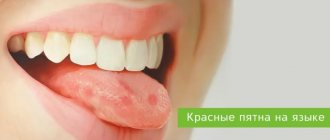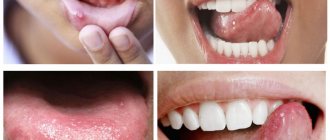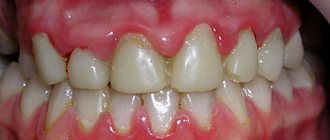The tongue is needed to recognize the taste of food, but, in addition, it is a kind of indicator of human health. Any changes on its surface signal problems in the body . For example, red spots on the tongue of an adult or child may appear due to the development of stomatitis, scarlet fever, diseases of the gallbladder, intestines, problems with the heart, liver or kidneys.
What changes can there be in the language?
Every morning and evening, after brushing your teeth, it is necessary to examine the oral cavity for pathological changes. The procedure, which only takes one or two minutes, helps to avoid serious illnesses. If a red spot appears on the tongue, it may indicate the development of an allergic reaction, internal or local infectious pathology. With such a symptom you should consult a doctor.
The tongue of a healthy person should be uniformly pink in color, without changes in relief, moist, clean, not enlarged, painless, and moderately sensitive. Pathological changes can be very diverse - from simple redness to ulceration. Here are the main ones:
- neoplasms;
- itching;
- plaque;
- color change;
- ulcers;
- dashes;
- spots of various colors;
- wounds;
- plaques.
It must be remembered that many changes in the language appear for serious reasons and may not be very noticeable at first. Some, such as plaque or discoloration, may not cause discomfort to a person, but this is not a reason to let the situation take its course. The most common problem is stains.
Types of spots on the tongue and the reasons for their appearance
The spots can be of different colors: red, white, yellow, pink, brown and even black. The location of the spots also varies widely: at the tip, at the root, under the tongue or on the sides. Even the relief of the formations may differ from the relief of healthy tissues, which is associated with atrophy of the taste buds.
Photo: white spot on the tongue of an adult
There may be several spots or just one. They come in big and small, round and dotted. It is important to remember that any spots on the tongue indicate problems in the body. All of them are a deviation from the norm and necessarily require a doctor’s diagnosis.
Why do red spots appear on the tongue?
The tongue may become covered with red spots for the following reasons:
- A red spot or blister that does not go away for a long time may indicate such a terrible disease as cancer. Therefore, if it is detected, you should immediately seek medical help.
Scarlet feverAnother reason for the appearance of red spots on the tongue is scarlet fever. Children are most often affected by this disease. In the early stages of the disease, the spots are surrounded by bubbles; when they burst, small ulcers form in their place.
- Another terrible disease in which red spots form on the mucous membrane of the tongue is AIDS. Such spots are localized at the tip or at the root of the organ; they usually protrude above the general surface, reach 7–8 mm in width and are covered with a pale gray coating. Lymph nodes with this disease are always enlarged.
StomatitisStomatitis is far from the least important cause of the appearance of red spots. Most often, dental red spots are located on the root of the tongue, sometimes they are only surrounded by a red halo, but inside are covered with a white coating.
- If red dots and a white coating appear on the tongue, this is the so-called geographic tongue. This disease often occurs in children and pregnant women.
- Hemorrhages can also cause spotting. However, they are usually accompanied by the appearance of red dots on the tip of the tongue, and not full-fledged spots. Hemorrhage may indicate a disease such as mononucleosis.
- The mucous membrane of the taste organ may become colored after eating food with dyes.
- Allergic reaction.
- Mechanical or chemical damage (burns, wounds).
Brown spots on the tongue
There are few reasons why brown spots may appear on the tongue:
Smoking. This bad habit contributes to the formation of an unaesthetic brown dark plaque on the mucous membranes of the mouth and teeth.- Eating food with dyes, chocolate, large amounts of tea or coffee gives a spotty effect.
- The light brown color of the spot indicates problems with joints or diseases of the upper respiratory tract.
- Brown spots with a yellow tint indicate dependence on alcohol, diseases of the lungs and bronchi, as well as drug intoxication.
A dark spot on the tongue is an alarming sign. In this way, the body reflects problems with the gastrointestinal tract, “talks” about kidney and liver diseases, and problems with the gallbladder. If a dark spot is detected, you need to undergo a comprehensive examination in the clinic, identify the cause of the disease and eliminate it.
Red spots and dots on the tongue with a white coating
In both adults and children, red spots on the tongue can appear in tandem with a white coating. Red spots with plaque appear on the tongue against the background of such pathologies:
- Constipation. Prolonged constipation causes intestinal problems, which in turn affects the entire body and can lead to red circles on the tongue.
- Poisoning. This disease can cause small red dots and plaque to appear on the tongue.
- Lack of vitamins and nutrients. With vitamin deficiency, the color of the surface of the tongue often changes to pale with small specks. Weakness, lethargy, and pallor of the skin are added to spotting.
- Kidney dysfunction. Round pink spots form on the tongue.
- Inflammation. Redness of the taste organ may be accompanied by burning, pain, irritation and increased sensitivity to hot and cold.
The tongue becomes covered with a white coating due to many diseases. Even a common cold, poor diet, or the wrong medication can lead to the formation of plaque in the mouth.
Causes of a “bald” tongue
“Bald” spots on the tongue indicate atrophy of the taste buds. With this pathology, some areas of the tongue become completely smooth, as if polished, and acquire a pinkish or bright red color.
Causes of pathology:
- Burns that quickly pass, and the “bald spot” is again overgrown with papillae. A burn is always accompanied by a burning sensation.
- Lack of vitamins and nutrients: B1, B2, B12, PP, proteins.
- Chronic malnutrition.
- Anemia.
- Smoking.
- Infections.
- Excessive alcohol consumption.
- Dehydration.
Redness of the entire surface of the tongue and its “baldness” are often caused by chemotherapy. Smooth pink spots appear with psoriasis.
Other pathologies
Black, blue, green, yellow spots and plaques on the tongue are not as common as those listed above. What do they mean:
- Black spots occur due to fungal infection or iron oxidation - in the presence of piercings.
Photo of plaques on the tongue with leukoplakiaYellow is a common symptom of jaundice. With this disease, the skin of the body also acquires a yellow tint.
- Green - can be either a symptom of candidiasis (fungal infection) or a consequence of smoking, damage to the mucous membrane or oxidation of the piercing.
- Blue ones are often harbingers of more serious pathologies, such as cancer or pneumonia. The tongue is blue in case of sepsis, bronchial asthma, all kinds of heart defects or poisoning. Most often, the reason for the appearance of blue spots on the tongue is problems in the functioning of the human respiratory system.
- Formations in the form of plaques appear on the mucous membranes of leukoplakia due to too rapid growth of benign cells.
What should not be done and used?
You should not carry out treatment on your own. Many remedies can only aggravate the conditions of both children and adults. Therefore, it is worth remembering what not to do if red spots appear on the tongue:
Antibacterial drugs
First, oral diseases themselves are not treated with oral antibiotics. Uncontrolled use can provoke a disruption of the microflora of the entire body. Local use of such drugs should be very careful. Only special means are suitable for this.
Secondly, improper use of antibiotics can lead to pathogenic microflora becoming accustomed to the drug.
Folk remedies
Particular caution should be exercised towards those components that have not yet been used and have not been used specifically for a sick person. All folk remedies are based on natural products, and, as you know, they can become a strong allergen, especially for a small patient.
Intensive multivitamin intake
Unfortunately, both lack and excess of vitamins can lead to negative consequences. Therefore, taking them can sometimes only worsen the situation.
Potent antiseptic solutions
These include iodine, brilliant green solution, and high concentration hydrogen peroxide. They should not be used on open wounds or taken orally.
Alcohol based products
It is better to exclude them from use completely when it comes to treating problems in the oral cavity. These products include compresses and ointments containing alcohol. There are also recommendations for the use of kerosene - this is also a very aggressive component, which, like alcohol, will cause severe burns to the entire mucous membrane of the oral cavity.
Why do spots appear on a child’s tongue?
Specks and dots on a child’s tongue may consist of bacteria and leukocytes that died during the inflammatory process, particles of exfoliated epithelium, and food debris. Also, the cause of a partial change in the color of the taste organ can be the formation of benign and malignant neoplasms.
White circles most often appear on the tongues of infants. The surface of the mucous membrane becomes covered with a cheesy coating or loose specks, which indicate the development of a fungal infection - thrush. This disease manifests itself in babies due to their fragile immunity in tandem with infection through a pacifier licked by a mother who has had candidiasis, dirty hands, and kisses.
The surface of the mucous membrane under the plaque is ulcerated, so when you try to remove it, the tongue begins to hurt. You should not try to clean the baby’s tongue from deposits; it is better to resort to treating the mucous membrane with a soda solution.
Yellow spots at the root of the tongue may indicate poor functioning of the baby’s digestive system. Typically, diseases of the gastrointestinal tract are accompanied by the appearance of bad breath, stool disturbances, and possible abdominal pain and vomiting.
Any dark spots on the baby's tongue are not dangerous, since in most cases they arise as a result of staining of the mucous membrane with food. However, if the strange color does not disappear for a long time, you should urgently contact your pediatrician.
“Bald” areas appear on children’s tongues for the same reason as in adults – due to atrophy of the taste buds. Most often, this pathology develops when burned by hot food, traumatic injury, or inflammatory diseases. It cannot be treated and does not affect the child’s health.
Which doctor should you contact?
Few people know which specialist to contact if their tongue becomes stained. In fact, a whole group of doctors can help establish the cause of the disease and get rid of it: a dermatovenerologist, an ENT doctor, a surgeon, a dentist, a pulmonologist, a gastroenterologist and others. The first thing the patient should do is visit a therapist or dentist, who, if necessary, will refer him to a more specialized specialist.
Any pathology, be it small red dots or redness of the entire surface of the tongue, requires timely consultation with a competent doctor.
When should you be wary?
Usually the story of a hairy black tongue is painless, says the ENT doctor. But sometimes it turns into glossitis, that is, inflammation. “Here the organ itself becomes inflamed, its muscular layer, the papillary layer, becomes inflamed, the tongue becomes difficult to move, it swells in the mouth, and sometimes it does not fit in the mouth at all, and can even cause suffocation. In this case, a person should contact an ENT specialist to begin treatment,” says Vladimir Zaitsev.
Article on the topic
Why clean your tongue? 5 effective ways of oral hygiene
Treatment
Your doctor will tell you how to treat various pathological conditions. The most difficult thing is to get an appointment with the right specialist and determine the problem, because treatment will be aimed not so much at eliminating the external defect, but at relieving the internal disease.
Therapy for some diseases may take only a few days, while for others it may take months or even years. The duration of treatment depends not only on the type of disease, but also on the degree of its neglect. That is why doctors recommend closely monitoring your health and not delaying a visit to a medical facility, even if the pathology seems insignificant. Don't ignore even a little redness.
How to treat?
“Treatment includes several main areas - examination and determination of the level of hygiene, followed by professional cleaning with special solutions and brushes. A smear is also taken from the surface of the tongue to determine the pathological composition of plaque in the laboratory and select effective drugs,” says Ilya Antonov. He notes that such a syndrome can be false and becomes a consequence of severe systemic diseases, such as leukoplakia and Addison's disease.
“To exclude these diagnoses, the dentist refers the patient for additional studies. In any case, you should not hope that the situation can be dealt with using home remedies. Therefore, you should consult a doctor,” says Ilya Antonov.
Otorhinolaryngologist Zaitsev, in turn, notes that one must pay attention to the controllability or uncontrollability of the situation. “A controlled state is when it is enough to give up some foods or the same medications for the situation to gradually level out. An uncontrollable situation is when a person goes on a diet, and a strict one, but the situation does not change. In this case, it is necessary to consult a doctor and not delay,” says Vladimir Zaitsev. After all, the situation, as doctors emphasize, can be quite serious, and there is no point in wasting time, as this will directly affect the outcome of treatment.










